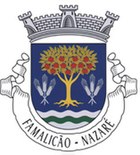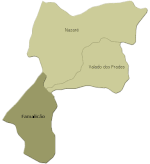Famalicão (Nazaré)
| Famalicão | ||||||
|---|---|---|---|---|---|---|
|
||||||
| Basic data | ||||||
| Region : | Centro | |||||
| Sub-region : | Oeste | |||||
| District : | Leiria | |||||
| Concelho : | Nazaré | |||||
| Coordinates : | 39 ° 32 ′ N , 9 ° 5 ′ W | |||||
| Residents: | 1740 (as of June 30, 2011) | |||||
| Surface: | 21.72 km² (as of January 1, 2010) | |||||
| Population density : | 80 inhabitants per km² | |||||
Famalicão is a Portuguese parish ( Freguesia ) in Nazaré County and Leiria District . It has 1740 inhabitants (as of June 30, 2011) and an area of 21.7 km², thus a population density of 80.1 inhabitants per km². Until the 18th century Famalicão was divided into Famalicão de Baixa (Lower Famalicão) and Famalicão de Cima (Upper Famalicão), the first municipality belonging to the city of Alfeizerão , the second belonging to Pederneira (now Nazaré ).
geography
The place Famalicão stretches from the foot of the mountain range, the Serra da Pescaria , which extends there along the Atlantic , up to the almost 100 meter high hill, from where you have a wide view of the Atlantic and the coastal region. That is why construction activity there has recently been increasing. In the north the municipality borders on the city of Nazaré , in the east on the city of Alfeizerão and in the south on the city of São Martinho do Porto . Towards the sea, Praia do Salgado is one of the most beautiful beaches in the region with an extensive dune zone towards the Serra da Pescaria, on the northern side of which is the church of São Gião . In the Serra da Pescaria and the municipal area adjoining inland, such as the hamlet of Quinta Nova, agriculture and fruit growing are practiced. There are also woodworking and ceramics industries there.
history
The residents of Famalicão de Cima came from the former city of Paredes da Vitória , also located on the Atlantic Ocean, about 15 km north , one of the thirteen cities of the Coutos de Alcobaça , the historical domain of the Abbey of Alcobaça , and brought the worship of Nossa Senhora de from there Vítória with, an image of Mary that was lost and has now been replaced by another image in the Igreja de Nossa Senhora da Vítória (Church of Our Lady of Victory) in Famalicão. The population living in Famalicão de Baixa belonged to Alfeizerão , another of the thirteen cities of the Coutos de Alcobaça, which, as in the entire area and especially through the Abbey of Alcobaça , emphasized the veneration of the Nossa Senhora da Nazaré . Over the centuries, however, the followers of the Nossa Senhora de Vítória prevailed in Famalicão and since then Famalicão is the only community in Portugal to have the peculiarity of this veneration. The worship takes place in August. In the church of Nossa Senhora da Vítória there is also a stone sculpture depicting the Trinity, which dates from the 15th and 16th centuries. Century. It is believed that the sculpture comes from the probably early Christian church of São Gião , which is also located in Famalicão , and was taken over by Famalicão in the parish church of Nossa Senhora da Vítória when it began to deteriorate in the 18th century. The parish church probably dates from the first half of the 17th century.
On the northern side, Famalicão still bordered the Bay of Nazaré and the port of Pederneira located there in the Middle Ages , an area that has silted up in the last three hundred years. At this siltation area , the entire dunes in Famalicão should include. The Quinta de São Gião, the site of the church of the same name, is located in the former coastal zone. Utensils from both Roman and Visigoth times have been found in this area. According to the opinion of Portuguese authors, although doubted but represented by international archaeologists, the church of São Gião was built on a Roman Neptune temple that had previously stood there. According to legend, the Roman consul Décio Juno Bruto is said to have built this temple in gratitude to the gods because of a battle won there between 140 and 130 BC. These indications definitely show that Famalicão was already settled in Roman times.
literature
- Achim Arbeiter : Architecture and Cult in the Visigothic Period. The Church of São Gião de Nazaré , in: Finds in Portugal , eds. H. Schubart, AA and S. Noack-Haley, Göttingen, Zurich 1993 (great moments in archeology), 177–196, plates 54–57
- Helmut Schlunk: La Iglesia de S. Gião, cerca de Nazaré , Congresso Nacionale de Arqueologia, Coimbra, 1970. Actas Coimbra: Ministério da Edução Nacional
Individual evidence
- ↑ www.ine.pt - indicator resident population by place of residence and sex; Decennial in the database of the Instituto Nacional de Estatística
- ↑ Overview of code assignments from Freguesias on epp.eurostat.ec.europa.eu
Web links
- Map of the Freguesia Famalicão (Nazaré) at the Instituto Geográfico do Exército
- pt: Nossa Senhora da Vitória
- pt: Igreja de Nossa Senhora da Victória de Famalicão



